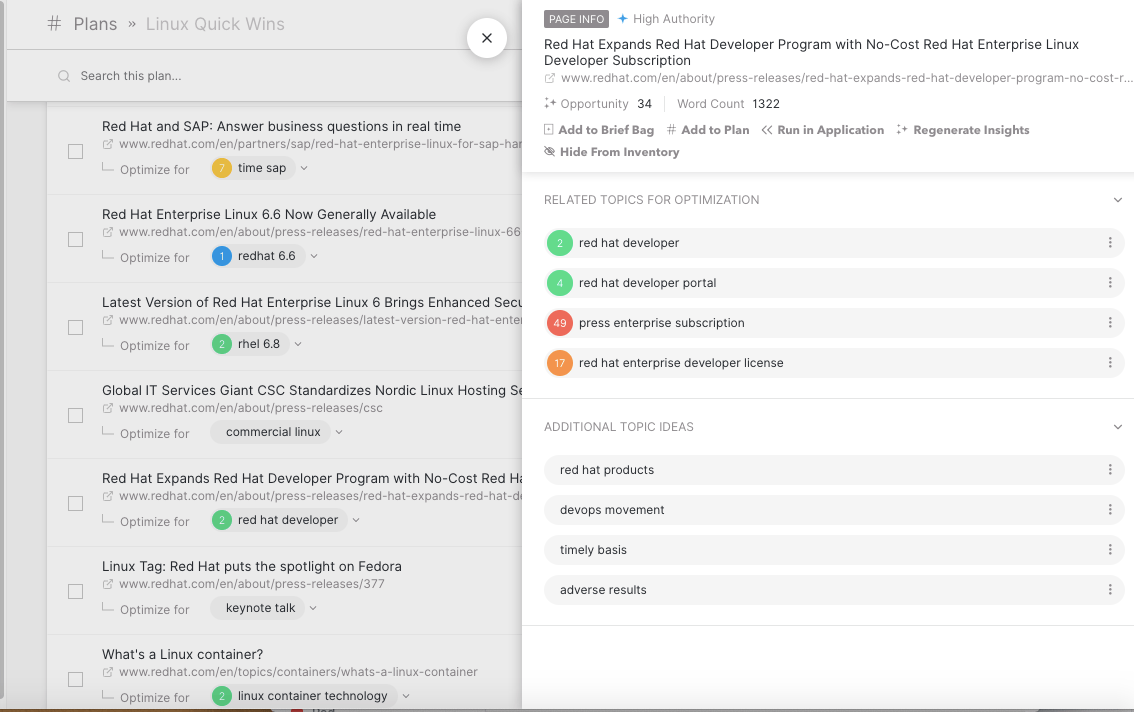Scaling Content Production With Technology
In the early days of the telephone switchboard operators had to physically connect every call by inserting a pair of phone plugs into the appropriate jacks. At its peak, over 350,000 switchboard operators worked for AT&T.
But there were limits to scaling in this manner. Adding more operators merely had an incremental effect. It certainly did nothing to address the human limitations of physically connecting those phone plugs.
Today, billions of calls are made daily, and scaling of this magnitude would not be possible without the aid of technology.
Compared to this, your content aspirations are modest. Still, if you wish to scale your content creation, it makes sense to look at how technology can help.

A great deal of online discussion around scaling content production often centers on issues related to personnel. While questions like whether to expand your in-house team or hire more freelancers are valid, this article focuses on how technology can augment your content team.
Defining Content Production Goals
First off, consider why it has become important to scale content. According to a CMI study, “93% view content as an asset” but only 42% strongly agree with that statement.
If you’re in that minority, then perhaps you view content as a strategic asset you can leverage for greater market dominance. On the other hand, maybe you’ve fallen behind the competition. Everywhere you look, they dominate the search results, and you don’t. So now you’re playing catch-up.
Which leads to another issue to consider. Where do you fit into the current content ecosystem? Some food for thought is mapping out the relationships between your websites, content-related teams, audiences, channels, systems, and guidelines.
At the same time, you’ll get a better idea where your company at with your content marketing operation. Do you work in a content of culture where realistic expectations are met with an adequate budget? Remember that content is a long play. So don’t be disappointed if ramping up content production doesn’t immediately result in a corresponding increase in organic traffic and leads.
These things take a certain amount of commitment, and it can be challenging to get an appropriate budget if you lack a sound content strategy.
What are you hoping to achieve by increasing content production? Do you need more content, do you need better content, or do you need both? Most organizations fall into the latter category.
I’ve never heard anyone say “We’ve got too much great content out there, so we have to cut back.” Never. Ever.
What systems are in place to scale content creation and distribution? It’s unlikely you’re starting from scratch, so review your current assets, taking into things like account people, technology, current content, and budget.
Basically, it’s an exercise of saying “here’s where I want to be and here’s what I have.” What resources are needed to address that gap?
Often, goals are stated in terms of “we need to produce ‘X’ blog posts per week, ‘Y’ case studies per month and ‘Z’ white-papers per quarter. However, the amount of effort between the different types of content varies considerably, making it challenging when trying to budget.
One idea is to look at the word count estimates as a better way of determining content production requirements. So if your production rate is x-thousands of words per week with your current team, you can take a back-of-the-napkin approach in determining the resources required to increase output by 50%, for example.
Structuring a Content Team
Content creation usually works best when all stakeholders are involved in the process. At a minimum, you’ll need people to fulfill the following roles:
- Content Strategist – determines content needs and format and creates content plans
- Content Manager – executes content plans by creating deadlines and allocating resources to the creation of the content described in the plans
- Content Creator – Conducts research, interviews subject matter experts and creates content that could be in written form, video, etc.
- Subject Matter Expert – works with the writer to ensure technical accuracy
- Designer – creates graphics, selects images, handles content design and layout
- Editor – edits for spelling, grammar and clarity, ensures content is on-brand and in-depth
Depending on the circumstance, some people may fill more than one role. Although scaling content production requires additional people, the relationship isn’t linear. This is especially true if you invest in the right technology.
Using Technology to Create Economies of Scale in The Content Production Process
How fast can content go from ideation to market? That’s really the litmus test when it comes to evaluating efficiency, whether you’re producing content or creating a product.
Keep in mind that hiring additional personnel to scale content production doesn’t increase efficiency. Hiring ten times the people may produce ten times the content, but the rate of production remains the same.
Then there’s the burden rate to take into account. That’s the cost you pay for managing those that do the work. Optimizing this cost is difficult because it’s never easy to find the optimal balance when it comes to individual workload.
But the most significant benefit that technology brings to scaling content production is the ability to do things that until now were virtually impossible. Let’s look at an example.
Your marketing director just informed you that the company is doing a big push for Linux next quarter and content is needed to support that marketing strategy. With thousands of pages on your site, taking stock of your existing material to determine what can best be optimized a good way to start. Do this manually? Forget it!
Use a web crawler? No way! I don’t need to data overload. I need insight so I can take action.
Instead, I’ll open up my MarketMuse dashboard to find the pages in my inventory that discuss Linux.

Great. I’ve narrowed it from thousands of pages down to a few hundred. But that’s still too much. I need to find the low hanging fruit that can score me some quick wins.
Really, I’d like to know which of those hundreds of candidates are the best prospects on which to work.
I could get my content strategy team to put together a spreadsheet report of all these URLs looking at things like:
- Content Quality
- Content Comprehensiveness
- Search Volume
- Topical Authority
- Site Authority
- Competition
- Variants
- Relevance
- Current Coverage
But realistically, that’s never going to happen. It’s something that would require astronomical effort to accomplish.
That’s okay. I’ll just filter the results for the highest opportunity scores, so I have a list of content opportunities that are most likely to succeed.

Bam! In just a couple of minutes, we’ve accomplished something that would take an army of content strategists weeks or months to achieve.
Workflow and It’s Impact on Scaling Content Production
Gains in workflow efficiency pay enormous dividends in scaling production, but there is no one “right” workflow. In fact, technology should be able to adapt to any workflow scenario.
Batching tasks is proven to be a great way to increase efficiency at a granular level. Continuing with our Linux example, there’s more insight I want on the filtered inventory. I could do it immediately on that same screen.
However, maybe I want to continue my big-picture content strategy efforts. So I create my “Linux Quick Wins” plan onscreen and go about slicing and dicing the rest of my Linux inventory to develop additional plans.

Some may find this to be more efficient. Some may prefer to continue investigating individual pages. That’s fine. Whatever you’re most comfortable with.
Anytime, whether in inventory or plan, clicking on a page title provides additional information. Performing this page-level analysis with its topic-related information is something you could never scale, were you do conduct it manually. Fortunately, you don’t have to.

Here are a couple of content optimization workflows you should examine.
Flexible workflows are important, but there is another issue to be concerned about when scaling production. That has to do with quality.
Maintaining Quality While Scaling Production
Maintaining consistently high quality is a challenge in any content operation, but more so when operating at higher volumes. Creating a style guide to address that issue is something most content teams tackle early in the process. Yet, it’s not something that scales very well.
Likewise with establishing standards. They’re only helpful if you can measure and provide feedback for improvement at scale.
Take for example MarketMuse Content Score. This score is an indicator regarding quality as it relates to depth of content. It determines whether a writer adequately covers a topic in the manner that a subject matter expert would.
Supply a focus topic, paste content into the Optimizer application (or provide the URL of an existing page) and the app will generate a score. Along with that score is a list of related topics and their suggested distribution. Use this to discover the gaps within your content and improve its quality.

Since it only takes a couple of minutes, it’s definitely scalable. Also, it’s another instance of technology enabling something that otherwise would be virtually impossible. To manually replicate this, you would need to analyze hundreds of documents to create a topic model and record it in a spreadsheet.
Here’s how you can do it, but it’s just not practical for any operation regardless of the volume of content.
As a side note, this is a great way to answer the question of whether or not someone is a really good writer. Run their content through the Optimize app to see how their page compares to those ranking in the top spots on Google.
The Benefits of Scaling Content Production Using Technology
Where would we be if we still used telephone switchboard operators to connect our calls? Chances are you wouldn’t be reading this article as it’s doubtful we’d have a world wide web.
Doing stuff faster is great. Doing things better, even more so. But doing things you could never do before is the best.
That is the real value technology brings when it comes to scaling content production. It augments your team’s efforts, enabling them to accomplish things they had never considered.
What you should do now
When you’re ready… here are 3 ways we can help you publish better content, faster:
- Book time with MarketMuse Schedule a live demo with one of our strategists to see how MarketMuse can help your team reach their content goals.
- If you’d like to learn how to create better content faster, visit our blog. It’s full of resources to help scale content.
- If you know another marketer who’d enjoy reading this page, share it with them via email, LinkedIn, Twitter, or Facebook.
Stephen leads the content strategy blog for MarketMuse, an AI-powered Content Intelligence and Strategy Platform. You can connect with him on social or his personal blog.